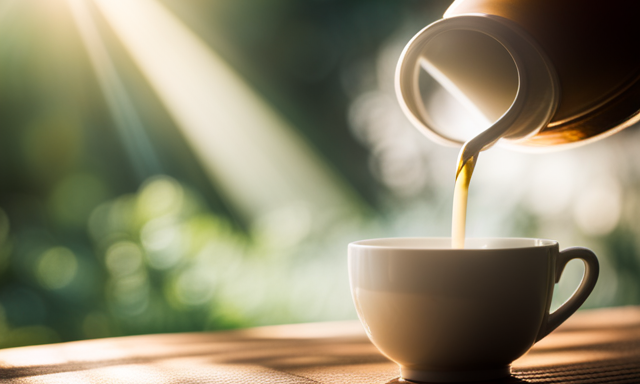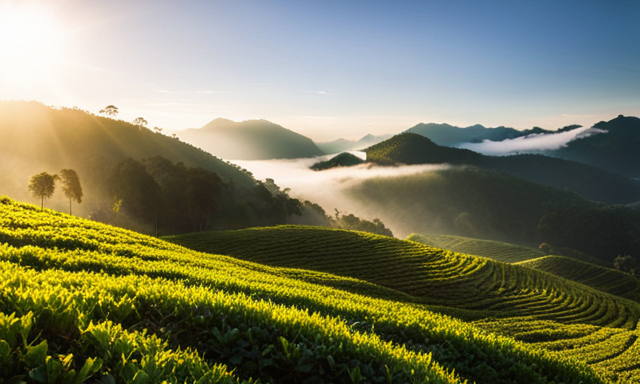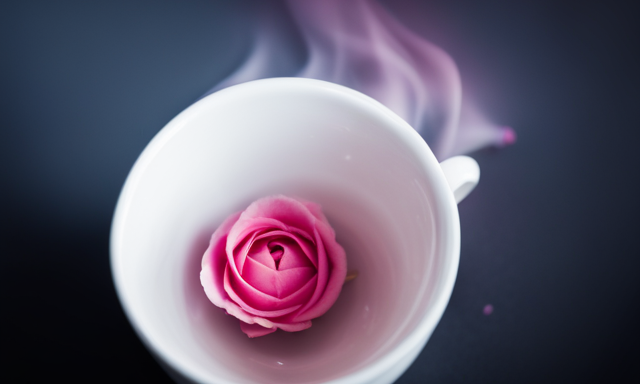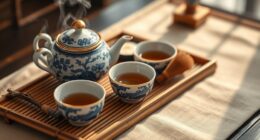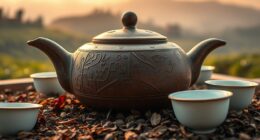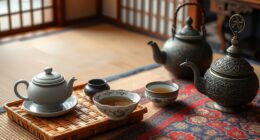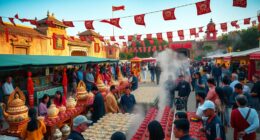Welcome, tea lovers! Are you ready to embark on a tantalizing journey through Taiwan’s tea wonderland? Look no further, as I am here to guide you on where to buy the finest oolong tea in this enchanting country.
From the charming Wistaria Tea House in Taipei to the picturesque Alishan Tea Plantations in Chiayi County, and the captivating Jiufen Old Street Tea Houses in New Taipei City, Taiwan offers a plethora of options for tea enthusiasts.
Immerse yourself in the rich culture and history of tea at the Taipei Tea Promotion Center or indulge in the art of tea appreciation at the Yingge Ceramics Museum.
Don’t fret if you can’t make it to Taiwan just yet, as we’ll also explore online tea retailers and local markets where you can find top-quality oolong tea.
So, get ready to sip, savor, and experience the true essence of Taiwan’s oolong tea. Let’s begin this tea-tastic adventure together!
Key Takeaways
- Wistaria Tea House in Taipei: Wide selection of oolong teas and charming ambiance. Provides information about origins and processing techniques of oolong tea.
- Alishan Tea Plantations in Chiayi County: Renowned for exceptional oolong tea production. Hand-picked and carefully processed tea leaves. Ideal climate and soil conditions for tea cultivation.
- Dong Ding Tea House in Nantou County: Famous for Dong Ding oolong tea and traditional tea-making process. Nantou County known for tea tourism and preservation of tea-making traditions.
- Taipei Tea Promotion Center in Taipei: Offers a wide range of high-quality oolong tea brands. Hosts tea tasting events and workshops for tea production and brewing techniques.
Wistaria Tea House in Taipei
If you’re in Taipei, you should definitely check out Wistaria Tea House to get your hands on some delicious oolong tea. As a tea enthusiast, this place is one of my top tea house recommendations in Taipei.
Wistaria Tea House not only offers a wide selection of oolong teas, but also has a charming ambiance that makes the tea-drinking experience even more enjoyable.
The history of oolong tea is fascinating, and Wistaria Tea House is the perfect place to learn more about it. The knowledgeable staff will gladly share the origins and processing techniques of oolong tea, giving you a deeper appreciation for this exquisite drink.
From the moment you step into the tea house, you’ll be transported to a world of tea culture and tradition.
Speaking of tea culture, let me take you to the next part of this journey – the breathtaking Alishan tea plantations in Chiayi County.
Alishan Tea Plantations in Chiayi County
Nestled in the picturesque Chiayi County, the enchanting Alishan Tea Plantations beckon visitors with their tranquil beauty and rich history. These tea plantations are renowned for their contribution to Alishan tea tourism and their exceptional oolong tea production techniques. The Alishan tea leaves are hand-picked and processed with utmost care, ensuring the highest quality and flavor. The unique climate and fertile soil of the region create the perfect conditions for tea cultivation, resulting in a distinct aroma and taste that is cherished by tea enthusiasts worldwide. To fully immerse yourself in the tea culture, a visit to the Alishan Tea Plantations is a must. Take in the breathtaking scenery as you learn about the traditional tea production methods passed down through generations. The experience is truly unforgettable. Continuing our tea journey, let’s explore the Dong Ding Tea House in Nantou County.
Dong Ding Tea House in Nantou County
When you visit Nantou County, make sure to stop by the Dong Ding Tea House. Here, you can indulge in the aromatic flavors of their famous Dong Ding oolong tea and learn about the traditional tea-making process from experienced tea masters.
The Dong Ding Tea House is an iconic destination for tea enthusiasts. It offers a unique opportunity to witness firsthand the intricate steps involved in dong ding tea production. From picking the leaves to roasting and brewing, every stage is meticulously performed to ensure the highest quality tea.
Nantou County is renowned for its tea tourism. It attracts visitors from around the world to explore its tea plantations and immerse themselves in the rich tea culture. The Dong Ding Tea House stands as a testament to the passion and dedication of the tea masters, who continue to preserve the traditions of tea-making in Nantou County.
As we move on to the next section about the Taipei Tea Promotion Center in Taipei, let’s delve deeper into the world of Taiwanese tea.
Taipei Tea Promotion Center in Taipei
When visiting the Taipei Tea Promotion Center in Taipei, I was thrilled to discover a wide range of oolong tea brands. The center offers a vast selection of high-quality teas, allowing tea enthusiasts like myself to explore different flavors and aromas.
Additionally, I had the opportunity to attend tea tasting events and workshops, where I learned about the intricate process of tea production and how to properly brew and appreciate oolong tea.
Lastly, the center also offers a variety of tea accessories and souvenirs, making it the perfect place to purchase unique and meaningful gifts for tea lovers.
Discover a Wide Range of Oolong Tea Brands
You can find a wide range of Oolong tea brands to choose from in Taiwan. As a tea lover, I’m thrilled by the variety of options available.
When it comes to Oolong tea, it’s not just about the taste but also about the experience. In Taiwan, you can explore different tea tasting techniques to fully appreciate the flavors and aromas of Oolong tea.
Additionally, Oolong tea is known for its numerous health benefits, such as boosting metabolism and improving digestion. Exploring the different brands allows you to discover the unique characteristics of each tea and find the perfect one for your taste preferences and health goals.
After immersing myself in the world of Oolong tea, I couldn’t wait to attend tea tasting events and workshops to further deepen my knowledge and passion for this incredible beverage.
Attend Tea Tasting Events and Workshops
Immerse yourself in the art of savoring the rich flavors and delicate aromas of Oolong tea by joining tea tasting events and workshops. Here, you can unlock the hidden treasures of this captivating beverage.
At these events, you’ll learn valuable tea tasting techniques that’ll enhance your appreciation for Oolong tea. The knowledgeable hosts will guide you through the process of steeping the leaves just right and show you how to properly taste the tea to fully experience its complex flavors.
Additionally, you’ll discover the health benefits of Oolong tea, such as its potential to aid in weight loss and improve digestion. These events provide a wonderful opportunity to connect with fellow tea enthusiasts and deepen your understanding of this ancient beverage.
After immersing yourself in the world of Oolong tea, you can then explore the next step of purchasing tea accessories and souvenirs.
Purchase Tea Accessories and Souvenirs
After attending tea tasting events and workshops in Taiwan, I couldn’t resist purchasing some tea accessories and souvenirs to enhance my oolong tea experience at home.
The shops in Taiwan offer a wide range of tea brewing techniques and tools, including tea infusers, teapots, and tea cups. Each accessory is carefully crafted and designed to bring out the best flavors and aromas of oolong tea. Not only do these accessories elevate the tea brewing process, but they also make for beautiful and functional souvenirs.
Additionally, the health benefits of oolong tea are well-known, including boosting metabolism, promoting heart health, and improving digestion. With the right accessories, I can fully enjoy these benefits while indulging in the rich and aromatic oolong tea.
Now, let’s take a trip to Jiufen Old Street tea houses in New Taipei City, where the tea culture thrives.
Jiufen Old Street Tea Houses in New Taipei City
When it comes to enjoying oolong tea in Taiwan, Jiufen Old Street Tea Houses in New Taipei City are the place to be. Situated high in the mountains, these tea houses offer breathtaking views while sipping on a warm cup of oolong tea.
Not only can you enjoy the tea, but you can also sample local tea snacks that perfectly complement the flavors of the tea. And if that’s not enough, there are also plenty of tea-themed souvenir shops where you can browse and find the perfect mementos to take home with you.
So, if you’re a tea lover like me, Jiufen Old Street Tea Houses are a must-visit destination for a truly unforgettable oolong tea experience.
Enjoy Oolong Tea with a View
Savor the breathtaking sights of Taiwan while indulging in a cup of delicious oolong tea. Taiwan is famous for its stunning landscapes, and what better way to enjoy them than with a hot cup of tea in hand?
One of the best places to do this is at the tea plantations, where you can take tours and learn about the fascinating process of tea production. Immerse yourself in the world of tea by attending tea appreciation classes, where experts will guide you through the different types and flavors of oolong tea.
As you sip on your tea, the scenic views of rolling hills and lush greenery will transport you to a state of tranquility. After enjoying your tea with a view, it’s time to sample some local tea snacks, which perfectly complement the flavors of oolong tea.
Sample Local Tea Snacks
Indulge in the delectable array of local tea snacks that perfectly complement the flavors of oolong tea. Whether you’re visiting a traditional tea house or sampling tea at a local market, experiencing the local tea culture is incomplete without trying the mouthwatering tea snacks. These snacks are carefully crafted to enhance the flavors of the tea and provide a delightful experience for your taste buds.
To fully immerse yourself in the tea culture, consider participating in a sample tea ceremony where you can learn about the traditional tea brewing techniques. Watch as the tea master skillfully prepares the tea, using precise movements and elegant gestures. It’s a mesmerizing experience that deepens your appreciation for this ancient art form.
Now that you’ve satisfied your cravings with the local tea snacks and witnessed the intricate tea ceremony, it’s time to browse the tea-themed souvenir shops. Here, you can find a wide range of tea-related products, from teapots and tea sets to tea leaves and tea-infused snacks. It’s the perfect opportunity to bring a piece of Taiwan’s tea culture back home with you.
Browse Tea-themed Souvenir Shops
After immersing yourself in the local tea culture, have you ever wondered what unique tea-themed souvenirs you can bring back home? Look no further! Taiwan is home to a variety of tea-themed souvenir shops that offer a range of exquisite and beautiful items.
Here are 3 must-have tea-themed souvenirs to consider:
-
Tea-themed ceramics: These beautifully crafted teapots, cups, and bowls are not only practical but also a work of art. They’re often adorned with intricate designs and patterns, making them perfect for tea enthusiasts and collectors alike.
-
Tea-scented candles: Bring the calming and soothing aroma of tea into your home with tea-scented candles. These candles’re made from natural tea leaves and emit a delightful fragrance that’ll transport you back to the tea-themed cafes you visited in Taiwan.
-
Tea-infused chocolates: Indulge in the unique combination of tea and chocolate with tea-infused chocolates. These delectable treats come in various flavors, such as oolong, green tea, and black tea, and make for a delightful gift for friends and family.
After exploring the tea-themed souvenir shops, why not continue your cultural journey by visiting the Yingge Ceramics Museum in New Taipei City?
Yingge Ceramics Museum in New Taipei City
Located in New Taipei City, the Yingge Ceramics Museum offers visitors a fascinating glimpse into the rich history and craftsmanship of Taiwanese ceramics. As an avid fan of tea and its cultural significance, I was captivated by the museum’s extensive collection of traditional pottery techniques. The museum showcases a wide range of ceramic artworks, including intricately designed teapots, tea sets, and decorative vases. One particularly impressive exhibit features the art of Yixing clay teapots, known for their unique ability to enhance the flavor of tea. The museum also offers workshops where visitors can try their hand at creating their own ceramic masterpieces. The Yingge Ceramics Museum truly embodies the passion and dedication of Taiwanese artisans. Moving on to the topic of purchasing oolong tea, let’s explore the convenient world of online tea retailers.
Online Tea Retailers
When it comes to buying oolong tea in Taiwan, exploring virtual tea shops is a must. These online retailers offer a wide selection of oolong tea options, allowing you to browse and discover new flavors from the comfort of your own home.
Not only can you order oolong tea directly to your doorstep, but you can also read reviews and compare prices to ensure you’re getting the best quality and value for your money.
Explore Virtual Tea Shops
While exploring virtual tea shops, you’ll quickly discover a wide variety of oolong tea options available for purchase in Taiwan. Here are three enticing reasons why you should dive into this virtual world of tea:
-
Explore tea gardens: Virtual tea shops offer immersive experiences where you can virtually visit the lush tea gardens of Taiwan. Witness the breathtaking landscapes and learn about the cultivation and production of oolong tea, connecting you to the origins of this exquisite beverage.
-
Virtual tea tasting: Indulge in the sensory pleasure of virtual tea tasting. These online shops provide detailed descriptions, brewing instructions, and even virtual tastings where you can savor the flavors and aroma of different oolong teas before making your purchase. It’s an immersive and educational journey for your taste buds.
-
Expand your knowledge: Virtual tea shops often have comprehensive information about the history, traditions, and health benefits of oolong tea. Engage with knowledgeable tea experts who can guide you through the rich and diverse world of oolong tea.
Now, let’s delve into the next exciting section where you can order oolong tea directly to your doorstep.
Order Oolong Tea Directly to Your Doorstep
Get ready to have the aromatic and delightful essence of oolong tea delivered right to your doorstep, so you can savor the flavors without leaving the comfort of your home. Oolong tea is not just a beverage; it’s a way of life in Taiwan. For centuries, this tea has been an integral part of their culture, with a rich history and cultural significance.
Oolong tea is known for its numerous health benefits, including boosting metabolism, improving digestion, and reducing the risk of heart disease. By incorporating oolong tea into your daily routine, you can enjoy these benefits while indulging in its exquisite taste.
Now, let’s transition into the next section where we’ll explore how to read reviews and compare prices to ensure you find the perfect oolong tea for you.
Read Reviews and Compare Prices
After ordering Oolong tea directly to my doorstep, I was eager to delve into the world of flavors that awaited me. I decided to make my search even more exciting by reading reviews and comparing prices.
This not only allowed me to discover new and unique tea blends but also helped me find the best deals available. Reading reviews gave me insight into the taste profiles and aroma of different Oolong teas, allowing me to make a more informed decision. Comparing prices ensured that I got the best value for my money, without compromising on quality.
With my newfound knowledge and a list of potential teas in hand, I was ready to explore the local markets and farmers’ markets, where I knew I could find an even wider variety of Oolong teas to satisfy my tea cravings.
Local Markets and Farmers’ Markets
When it comes to finding the best oolong tea in Taiwan, one of the most exciting ways to discover hidden gems is by exploring local markets and farmers’ markets. These vibrant and bustling places not only offer a wide variety of oolong tea options, but they also provide an opportunity to support local tea farmers and producers directly.
As I stroll through the market, I can’t help but be captivated by the rich aromas and vibrant atmosphere, making the experience of buying oolong tea even more enjoyable.
Discover Hidden Gems for Oolong Tea
Seek out the secret sanctuaries of sensational oolong tea in Taiwan and savor the splendid selection of hidden gems. Immerse yourself in the rich tea culture and discover tea plantations where the finest oolong tea is cultivated with care and expertise.
Experience the magic of traditional tea ceremonies, where the art of brewing tea is elevated to a spiritual practice. As you explore these hidden gems, you’ll encounter a world of flavors, from fragrant floral notes to robust earthy undertones. Delight in the crisp and refreshing taste of high mountain oolong or indulge in the smooth and velvety texture of roasted oolong.
Each sip brings you closer to the heart of Taiwan’s tea heritage. With every purchase, you support local tea farmers and producers, ensuring the continuation of this cherished tradition.
Transitioning into the subsequent section, let’s explore how to support these passionate individuals and their dedication to oolong tea.
Support Local Tea Farmers and Producers
Indulge in the authentic flavors and vibrant culture of local tea farmers and producers, supporting their dedication to preserving the rich heritage of oolong tea in Taiwan. Supporting local tea farmers is not only a way to experience the true essence of oolong tea, but also a means to promote sustainable tea production. By purchasing tea directly from these farmers, you are contributing to their livelihoods and ensuring the continuation of traditional tea cultivation methods. These farmers have a deep understanding of the land, climate, and techniques required to produce the finest oolong tea. To further emphasize the importance of sustainable tea production, here is a table showcasing the benefits of supporting local tea farmers:
| Benefits of Supporting Local Tea Farmers |
|---|
| 1. Preserves traditional tea cultivation methods |
| 2. Supports local economy |
| 3. Promotes sustainable farming practices |
| 4. Ensures high quality and authentic tea |
| 5. Fosters a sense of community and cultural heritage |
By supporting local tea farmers, you not only enjoy the best oolong tea but also contribute to a sustainable and vibrant market atmosphere.
Enjoy a Vibrant Market Atmosphere
Immerse yourself in a bustling tapestry of colors, aromas, and sounds as you step into the vibrant world of local markets. The air is filled with the energy of eager shoppers and the stalls are like a lively symphony of flavors and treasures.
The markets in Taiwan are not just a place to buy oolong tea, they are an experience that fully immerses you in the rich tea traditions and tea ceremonies of the country. As you navigate through the maze of vendors, you’ll discover an array of tea varieties, each with its own unique flavor profile and health benefits. Sip on a freshly brewed cup of oolong tea as you learn about the intricate art of tea making from the local tea farmers themselves.
The vibrant market atmosphere enhances the enjoyment of the tea experience, making it a truly memorable and immersive journey into Taiwan’s tea culture. As you savor every sip, you’ll be transported to a world of ancient traditions and modern delights.
[tea festivals and events] Celebrate tea in all its glory at the various tea festivals and events held throughout Taiwan.Tea Festivals and Events
Discover the vibrant world of tea festivals and events in Taiwan, where you can fully immerse yourself in the rich culture and traditions surrounding oolong tea. These festivals and events are a celebration of everything tea-related, from the art of tea brewing techniques to the health benefits of oolong tea.
One of the most famous events is the Pinglin Tea Festival, held annually in New Taipei City. Here, you can witness tea growers showcasing their skills and learn about the intricate process of tea production.
Another must-visit event is the Dong Ding Oolong Tea Cultural Festival in Lugu Township, Nantou County. This festival offers a unique opportunity to taste different varieties of oolong tea and learn from tea experts.
Immerse yourself in the vibrant atmosphere of these events and discover the true essence of oolong tea in Taiwan.
Frequently Asked Questions
What are the opening hours of Wistaria Tea House in Taipei?
I’m not sure about the opening hours of Wistaria Tea House in Taipei, but I can tell you about other tea houses in the area. Taipei has a vibrant tea culture with many excellent tea shops to explore.
How do I get to Alishan Tea Plantations in Chiayi County?
To get to the breathtaking Alishan tea plantations in Chiayi County, I recommend taking a scenic train ride from Chiayi City to Alishan. The journey offers stunning views of the surrounding landscape and allows you to fully appreciate the beauty of these tea plantations.
Can I purchase Dong Ding tea online from Dong Ding Tea House in Nantou County?
You can purchase Dong Ding tea online from Dong Ding Tea House in Nantou County. It is known for its rich flavor and unique aroma. Drinking oolong tea has numerous health benefits, including boosting metabolism and improving heart health.
Is there an admission fee to visit Taipei Tea Promotion Center in Taipei?
No, there is no admission fee to visit the Taipei Tea Promotion Center in Taipei. It is a must-visit destination for tea enthusiasts, showcasing a wide variety of Oolong tea from all over Taiwan.
Are there any tea houses on Jiufen Old Street in New Taipei City that offer tea ceremonies?
Yes, there are tea houses on Jiufen Old Street in New Taipei City that offer tea ceremonies. These tea houses provide a unique and immersive tea ceremony experience, allowing visitors to fully appreciate the rich tea culture of Taiwan.
Conclusion
After exploring the vibrant tea culture in Taiwan, I’ve discovered that oolong tea can be found in abundance in various locations.
From the historic Wistaria Tea House in Taipei to the picturesque Alishan Tea Plantations in Chiayi County, there are countless places to purchase this exquisite tea.
The Dong Ding Tea House in Nantou County and the Taipei Tea Promotion Center also offer a wide selection of oolong teas.
For a more traditional experience, Jiufen Old Street Tea Houses and the Yingge Ceramics Museum in New Taipei City are must-visit destinations.
Additionally, online tea retailers, local markets, and farmers’ markets are excellent options to explore.
Don’t miss out on the exciting tea festivals and events that take place throughout the year.
Let the flavors of Taiwan’s oolong tea transport you to a world of sensory delight, where each sip is like a symphony of flavors dancing on your tongue.



